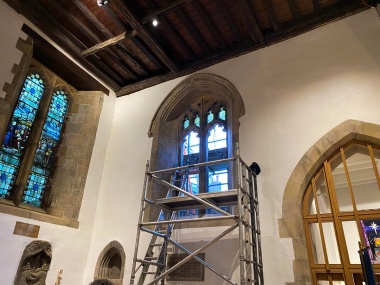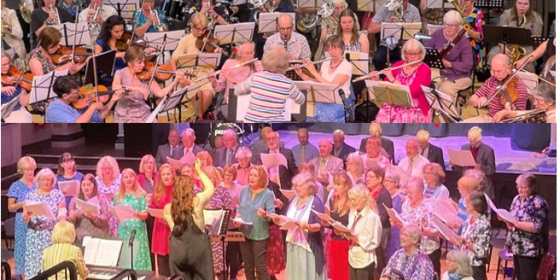Stained glass restoration – Step 1
On a crisp January morning, another one of St Mary's beautiful stained-glass windows was removed to be restored. Immerse yourself in the scenery and maybe even learn a little something about this wonderful craft...
13th January 2021Heritage
It’s a cold January morning in Barnard Castle, and St Mary’s Parish Church looks particularly picturesque with a dusting of fresh snow. Today is an important day for this historic building, as restoration work begins on one of the church’s beautiful stained-glass windows.
A staple in just about any Christian church, stained-glass is an art form that captures key religious persons and stories in delicate but intricate compositions. And, in such a historically vibrant centre as Barnard Castle’s own St Mary’s, features like these must be treated with the utmost care. This is where Jonathan Cooke comes in. He and his team have the privilege of removing and restoring the windows.

They immediately begin by chiselling away at the putty which seals the stained glass panels to the masonry. This soon proves to be a challenge. Usually, stained-glass windows are sealed around the perimeter with a mixture of sand and cement, which creates a mortar. However, Jonathan notes that it was sometimes the case in the 19thcentury to use putty instead. This past decision can add a bit of a challenge to the modern-day restoration process, as it becomes hard and brittle with age, making the process of removing a lot longer and harder on the wrists than mortar, which if properly mixed, should be weaker than the stone and the glass, to allow removal without damage. Additionally, with hindsight, putty isn’t the best choice, as the oils can actually be damaging to the masonry of the aperture. Regardless, the team powers through with the skill and patience that comes with years of experience.

And as the snow starts to melt away and the people of St Mary’s vibrant community go about their day, the first panel comes away and a burst of crisp air enters the church. The entire structure of the window is designed to aid installation and removal, and windows are divided into panels in such a way that, while they might appear to be one piece, individual panels can be more easily installed and removed as needed. The sharp tap, tap, tap of the chisels contrasts the gentle sound of the organist practicing, echoing through the building as the team works against the clock to embrace the short amount of daylight winter offers, striving to get the entire window removed in time for the early sunset.

Soon enough the next panel is freed, and the next, and the next. Until the window looks strangely bare compared to its fellows. Jonathan and his team will take the glass panes back to their own workshop, where they’ll carefully work on them over the next few weeks to bring them back to their original glory.
Keep an eye out for upcoming blogs, where we’ll hear more about just what the restoration process entails…
Check out Jonathan’s conservation business and more of his brilliant artwork with stained glass all over the country.
Follow us on Facebook
Get more updates and engage with the church community on our Facebook page


